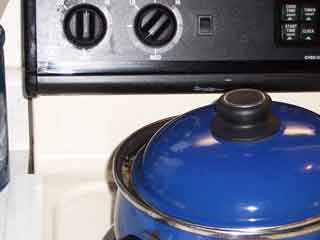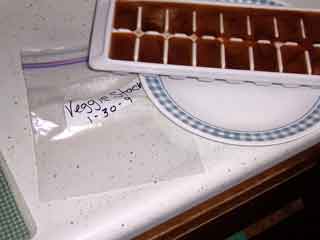‘Course that means you’ll need gallons of the stuff. No worries. Here’s how you do it.

At least once a month, save up your fresh vegetable scraps for a week (or so). Use those thin little bags you put your produce in at the grocery store to hold the scraps and keep it in the produce drawer in your refrigerator. If you’re careful to squeeze all the air out, then hold it closed and give the bag a spin to twist it tight, you can pull the open end over the sealed end, give it a shake and, voila, airtight sealed storage.
Now a week works for me. The scraps stay ‘fresh,’ the filled bag still fits in the produce drawer (with room for some actual produce, as well), and I end up with just enough scrap to fill my 3qt. saucepan. If you’re cooking for a crowd or just for yourself, you’ll have to figure out whether to save up for a shorter period or to make a smaller quantity of stock. The important part of the equation is: don’t let the scraps spoil.

What to save? Whatever you’ve got. Keep the trimmed ends of carrots, squashes, green beans, celery; the stalks from asparagus, broccoli, leafy greens; trimmings from lettuces, cabbages, Brussels sprouts; the ends and peels from red onions, yellow onions, shallots, cucumbers. . . And so on . . .
It may be easier to list what not to keep. No potato parts. No tomato parts. No seeds or membranes from bell peppers parts (or other peppers, either). No peels from waxed vegetables such as rutabagas or cucumbers. No fruits, nuts or garlic parts. I’m sure I’m forgetting (or have never thought of) dozens of others, but hopefully, you get the idea.

When your bag is full, dump it all into your saucepan. Push it down if need be to make it all fit and then fill the pot with water. No salt. No pepper. No nothing. Just pure plain water. And, as mentioned in other posts from time to time, if you live in a ‘water challenged’ area where you can taste the ‘water treatments,’ consider using bottled water for your stock.

Then simply put it on to heat. Start on high, but keep an eye on the pot (if you don’t already know how long it takes your pot that size, full of water, to come to a boil, now’s a good time to learn; watch the clock!)

As the pot nears a boil, take the cover off. You want the pot to reach a pretty full boil, but don’t want to let it boil over.

After it’s reached as much of a boil as you can manage without spilling over, put the cover back on, but leave it ajar, and turn the heat down to a serious simmer. Come back and check in 5 – 10 minutes. Still simmering? Not spitting over? Then you can leave it alone for 30 – 45 minutes. When you check back then, add some more water to bring the level back up near the top of the pot. And let it cook for another hour. More water; another hour.

Now you’ve got a good stock going. So pull the pot lid back a ways and leave it to simmer for a while more. Let the volume of liquid reduce to at least ¾ of the pot, maybe a little more. You want the vegetable scraps to give up all their value, but don’t want to let them start to dry out. When the liquid is down to near the top of the veggies, it’s time to strain.
You can use a fairly coarse strainer here; the idea is to remove (most of) the solid matter. The strained liquid will be reduced further and then strained again before storage. So just dump it into a colander or such and collect the liquid. The solids can be thrown out (or onto your compost heap).
Now, back to the pot and onto the stove for the hardest part of this whole thing. Reduce the liquid over medium heat (a bubbly simmer) to about 2 cups or the amount it takes to fill one of your ice cube trays. Most of mine hold about 14 ounces.

When you’re ready, strain the stock through your finest strainer into a container from which you can pour easily. Then pour the liquid into your ice cube tray. If the tray will sit atop other ice cube trays, be sure to avoid spills and drips – then again, maybe vegiie flavored ice cubes will start a whole new trend . . . And into the freezer.

In the morning (or afternoon or evening or. . .), remove the veggie stock cubes from the tray and store them in a ziplock in your freezer. At the concentrations described here, one cube in one cup of water makes one cup of delicious vegetable stock.
May have to make use of this one now that Morgan and I are in an apartment...
ReplyDeleteGreat news! Spend time in that kitchen . . .
ReplyDeleteAnd while you're looking for ideas, be sure to check out
28 Cooks, she's still doing great things with vegetables.
tommyj